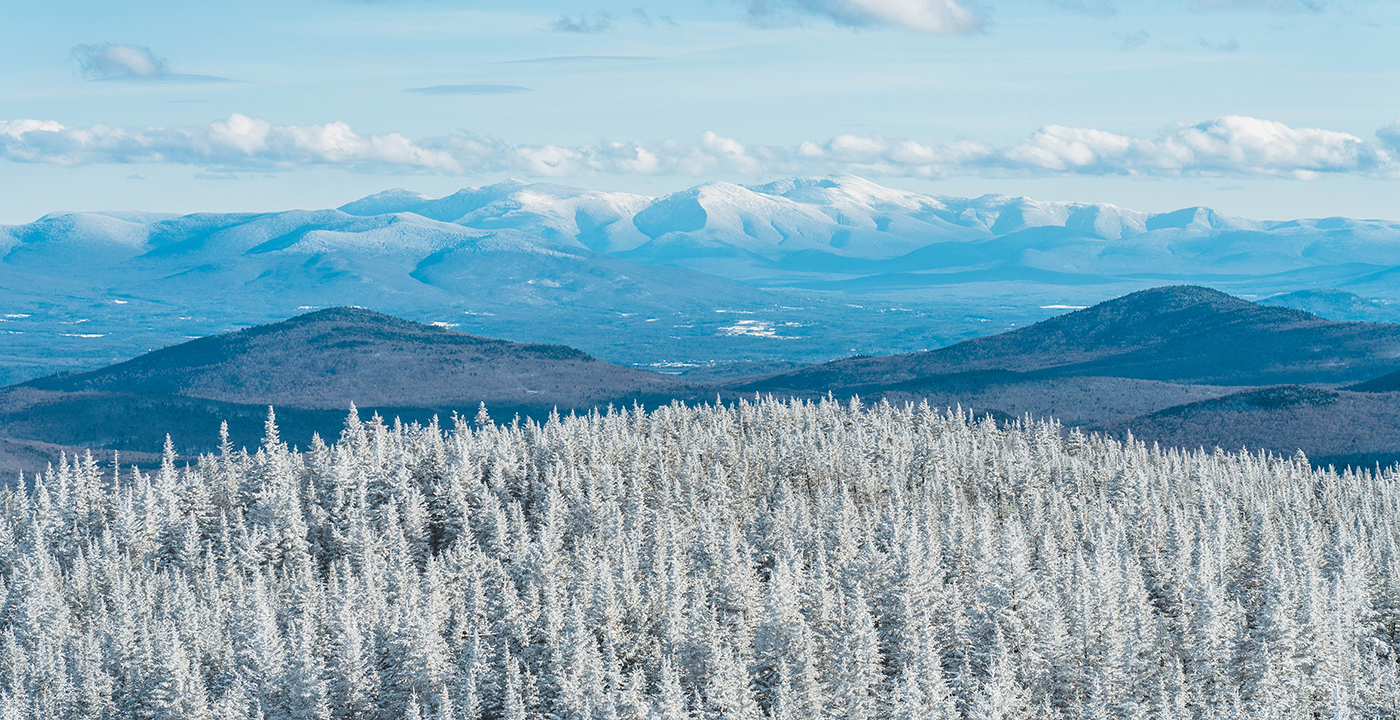

Snow cover in the New Hampshire mountains (seen here from East Haven, Vt.) has decreased every year and the season is now shorter, on average—one of the consequences of changing winters in the Northeast.
Winter has arrived in New Hampshire’s Pinkham Notch. How might a changing climate change the nature of winter in this special place? As AMC researchers have recently shown, climate change is already altering winter, resulting in a shorter, less snowy cold season here in the Northeast, on average. Tracking changes in the snowy months with on-the-ground weather observations are essential to understanding precisely how climate change is affecting winters in the region—especially in the mountains, where patterns of snow depth are complex and data are sparse.
Preparation for the darker, colder months started with snow monitoring equipment being installed at AMC’s Carter Notch, Lonesome Lake, and Zealand Falls Huts before the ground froze. Earlier this fall, AMC’s Research Department partnered with Nikki Becker, Observing Program Leader and meteorologist for National Weather Service (NWS) in Gray, Maine, to update and expand snow data monitoring equipment and protocols in the White Mountains.
This update required more than the simple click of a computer mouse. Hiking to each of the AMC huts that would remain open through the winter, staff hauled on packboards 10-foot snow stakes to measure the snowpack through the season; canisters to collect snow and measure the water equivalent of snowfall every 24 hours; stands for the snow canisters; snow boards and 40-inch snow sticks to measure 24-hour snowfall; and hardware and tools to install the equipment at each hut.
This partnership between the AMC and the NWS is not new. AMC has been collecting snow measurements for the NWS at Joe Dodge Lodge since the 1930s. However, this winter, AMC is formalizing and updating its snow observations at the high-elevation huts to collect more accurate and consistent measurements.
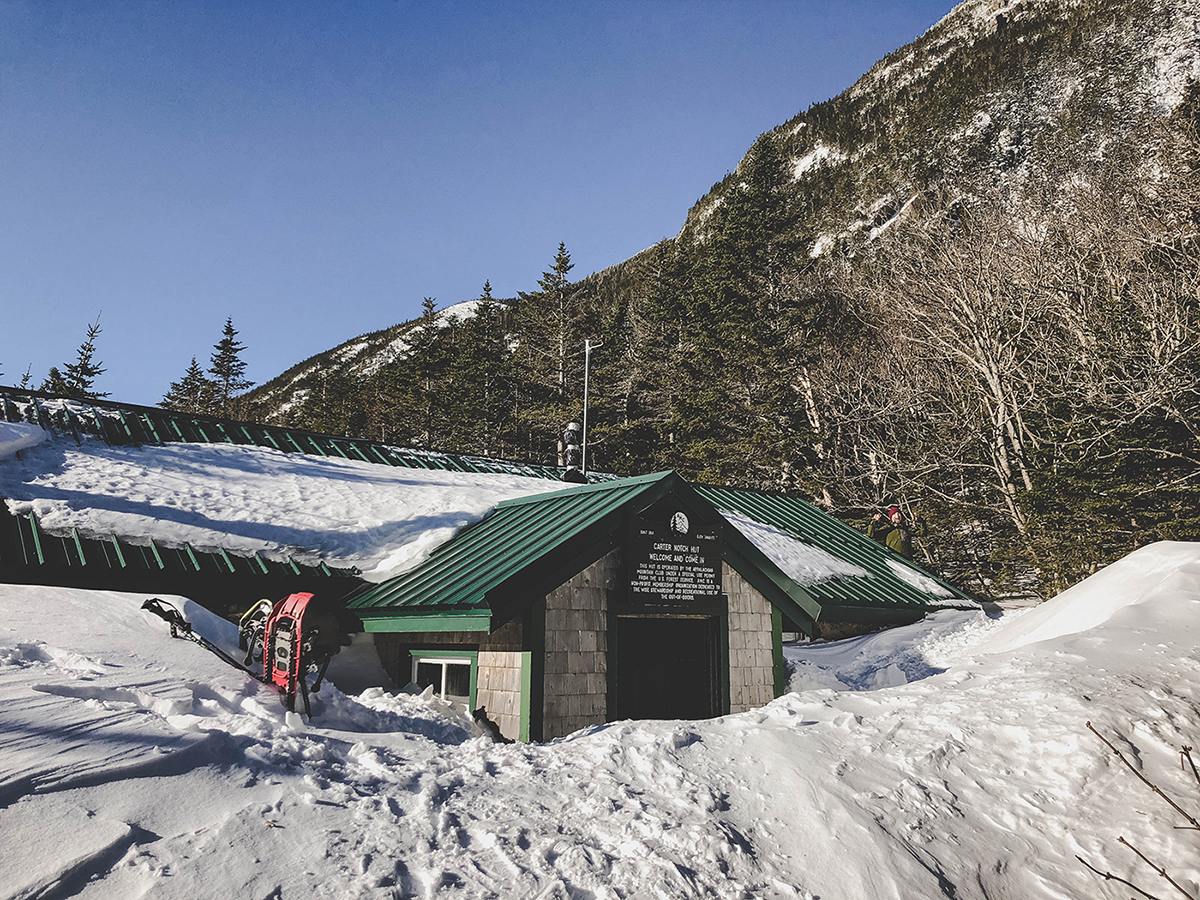

AMC Carter Notch Hut, located in the White Mountain National Forest, is now the site of snow observations and data collection, which are being used to study the extent of the Northeast’s changing winters.
The Mechanics of Snow Collection
Starting this year, staff at Carter Notch, Lonesome Lake, and Zealand Falls Huts will log the snow conditions daily, as they’ve done in the past, but will now also measure the total amount of water in the snow—known as the snow water equivalent. Every morning, the caretakers record four measurements to track the snow. First, they measure and record new snowfall. Snowfall is tracked as the depth of snow accumulates on a small, white board every 24 hours. Second, caretakers record the depth of the new and old snow remaining on the ground at the time of observation. This is also known as “snowpack” and is measured using the newly installed, 10-foot marked pole known as a snow stake. Third, caretakers measure the water equivalent of the snow. To collect this measurement, a tube that looks like a small rocket collects the snowfall over a 24-hour period, that snow is then melted, and the volume of the water is recorded. And lastly, caretakers record 24-hour maximum and minimum temperatures. Though the caretakers are not running models and making forecasts for their guests every morning, these “boots-on-the-ground” observations are essential in creating a long-term data set to assist both meteorologists and climate scientists for years to come. As Becker says, “forecasts are for today, but observations are forever.”
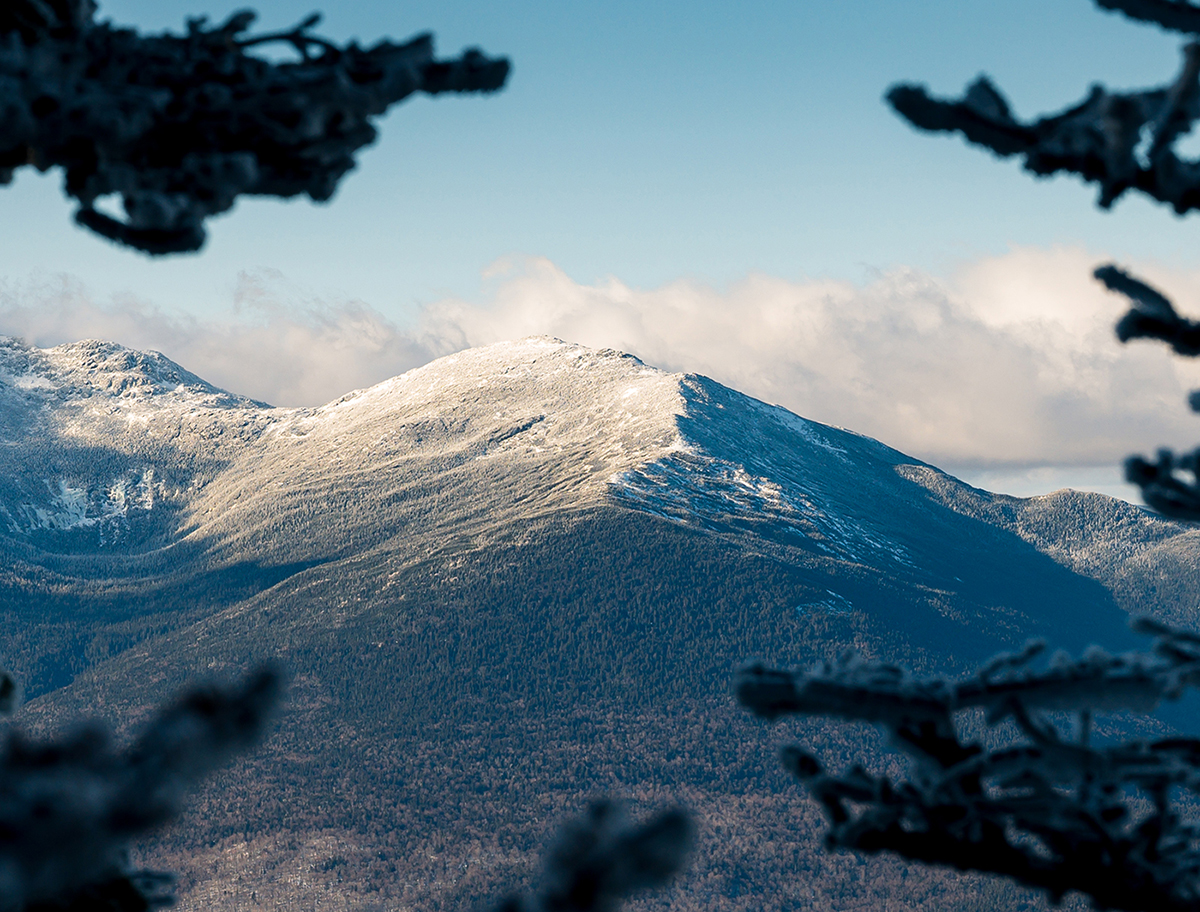

A winter view of Carter Dome in the White Mountain National Forest.
What Snow Samples Tell Us
These observations not only provide baseline information for meteorologists to produce more accurate mountain forecasting models for the future, they also add to a long-term climate data set that will shape our understanding of winters in the Northeast. Very few sites exist at these elevations, so AMC’s hut caretakers are providing data that improve mountain predictions. These snow plots also provide a baseline for future comparisons. “We don’t go back and look at what the forecast was 20 years ago, we look at what the weather was 20 years ago,” Becker says, speaking about the importance of continued winter data collection. Long-term data sets have shown that since 1917, on average, the Northeast has experienced 20 fewer frost days, 19 fewer days with snow cover, and winters that are roughly three weeks shorter. In New Hampshire’s mountains, Pinkham Notch and the summit of Mount Washington are warming every decade, and snowpack in the notch is melting earlier too, as AMC Staff Scientist Georgia Murray reported in her recent paper, “Climate Trends on the Highest Peak of the Northeast: Mt Washington, N.H.”
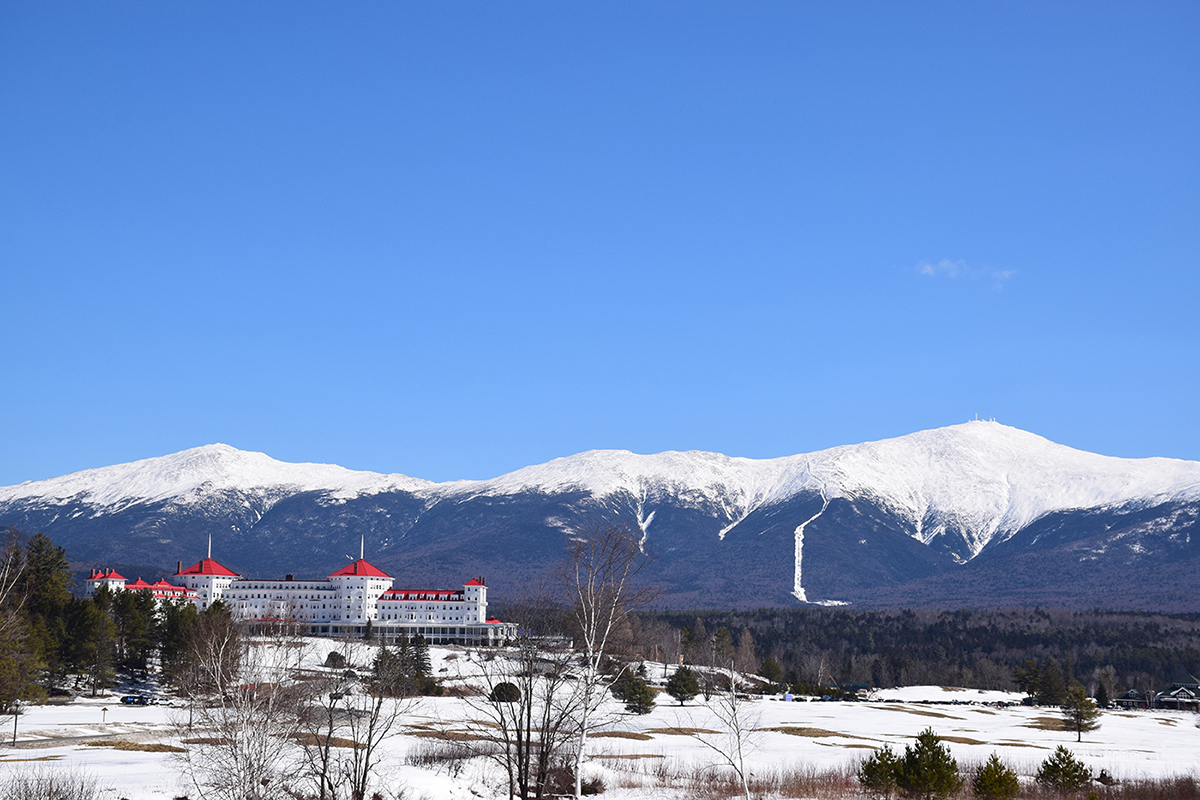

How might changing winters alter outdoor recreation around Mount Washington?
Far-Reaching Consequences
What might warmer, shorter winters mean for New England? For one, winter is a central piece of the culture in the Northeast, and whether it is something that you look forward to or dread, it is changing. For recreationists and mountain businesses, warming temperature means fewer days of snowfall and fewer days with snow on the ground. This is particularly troubling for backcountry skiers who rely on consistent snow and cold for their season. For farmers and plants alike, it means a longer growing season. Snowfall eventually leads to snowmelt. Understanding the water equivalent in snow and the volume of water that makes its way down mountains, into rivers, and through towns is also essential for preparing for spring, managing flooding, predicting drought, and creating hydroelectric power. As noted in a recent papers on changing winters co-authored by Sarah Nelson, AMC’s director of research, the ecosystems of the Northeast also rely on snow and snowmelt as an essential part of the water cycle. Winter snowpack helps insulate animals and soils from below-freezing temperatures in the coldest months and the timing of snowmelt in spring affects stream water quality and runoff. The changes in snowpack and snowmelt can have many cascading effects on our ecosystems. Several AMC research projects, including snow observations, contribute to our understanding of and adaptation to these changes to climate, winter, snow distribution, and water retention in the mountains of the Northeast. Projections through the end of the 21st century indicate that we stand to lose one to two more months of winter conditions, depending on whether we take a high- or low-emissions pathway, according to a new paper co-authored by Nelson.
While the AMC research team is excited about the long-term data sets that are being collected, these data also help the NWS keep people safe by providing information for weather warnings and forecasts. The data collected by AMC hut caretakers and recorded and synthesized at the NWS are all publicly available at the National Centers for Environmental Information.
“Wherever you get your weather, please check the forecast before recreating in the mountains, especially in the winter,” Becker adds as a reminder.
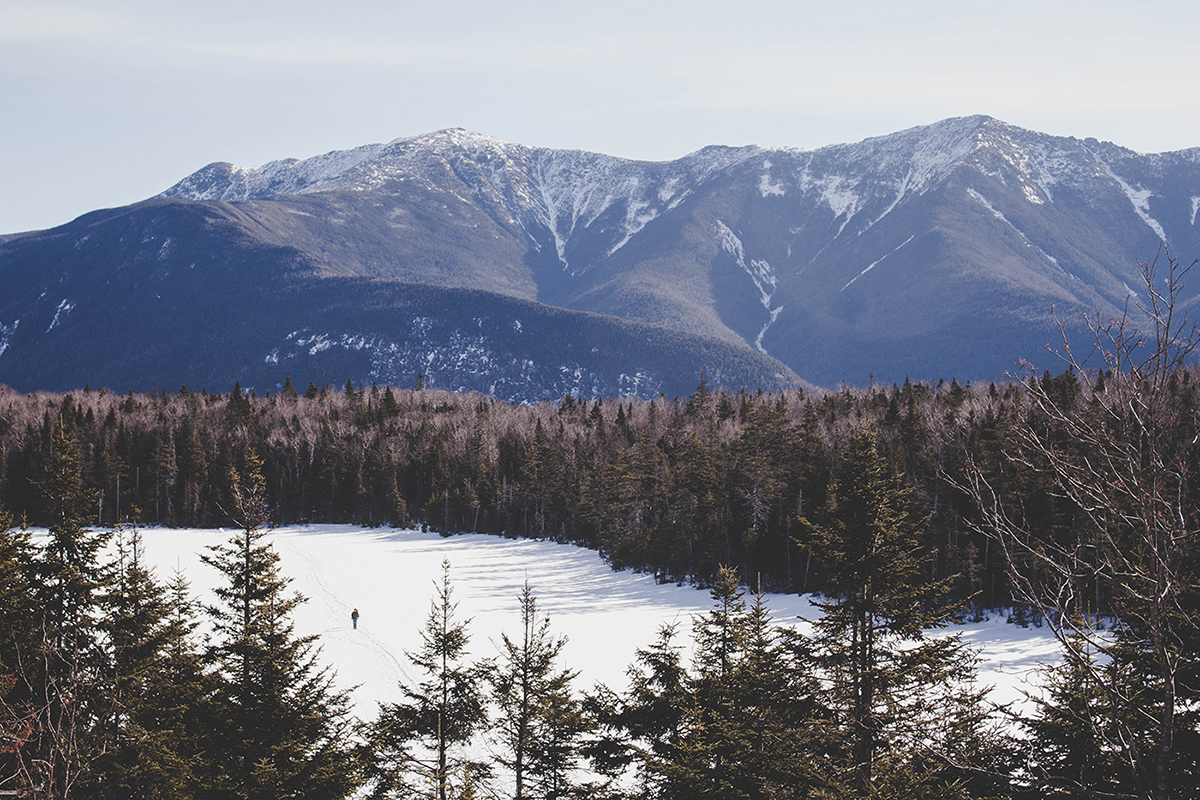

AMC caretakers, in cooperation with the National Weather Service, are collecting and observing snow samples at several of its high-mountain huts, including Lonesome Lake Hut.
Community Scientists Wanted
Providing “boots on the ground” support and snow data is not something that is just reserved for AMC staff members. Through programs like Community Snow Observations, the power of community scientists is also being harnessed. Where and when field measurements are not available, both temporally and spatially, snow cover models must simulate those gaps in the data. Community scientists can join the Community Snow Observations team and help fill those gaps. While community science data collection through Community Snow Observations is still taking shape in New England, initial research using citizen science data in the mountains of the western United States have shown that adding volunteer observations provides an even more accurate forecasting model when added to the NWS snow plot data set. That means each time a volunteer helps AMC collect data on snow, our climate understanding deepens and becomes more accurate.
“This winter, we encourage you to get out in the snow and harness your inner snow scientist,” Murray says.